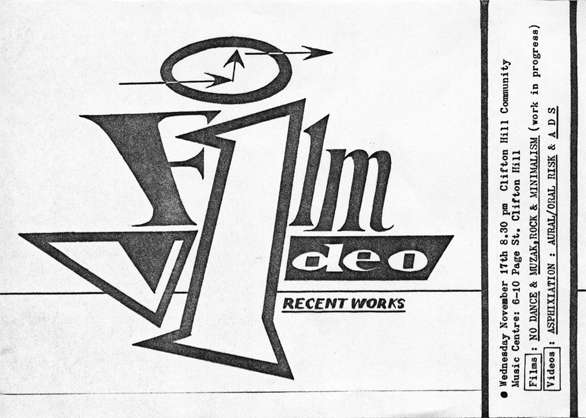Background
Ads is a cut-up/montage of images sourced from various television broadcast evening news shows. A companion piece to another early → ↑ → work, The News, its manipulation of broadcast media content initiates the audiovisual interrogation continued in the Evaporated Music series.
In Ads, the shots from the ads (most lasting only one or a few seconds) are thematically organized into 5 parts, each accompanied by a composed 'jingle'.
Ads (f) The Industry of Hands © 1982Credits
Editing & music - Philip Brophy
2024
VIDEO RAINBOWS - PS Art Space, Perth & Composite, Melbourne
2017
Collection purchase - Art Gallery of Western Australia, Perth
2010
VIDEO VOID - Centre for Contemporary Photography, Melbourne
1989
ARS ELECTRONICA - Linz
1986
6th French Chilean Video Art Festival, Santiago
Melbourne International Film Festival, Melbourne
DREAMSCAPES - Modern Image Makers, Glasshouse Theatre, Melbourne
1st AUSTRALIAN VIDEO ART FESTIVAL - Chauvel Cinema, Sydney
1985
Student Cultural Centre, Belgrade
TALKING BACK TO THE MEDIA - Time Based Arts, Amsterdam
1984
FUTURFALL - Bondi Pavilion Theatre, Sydney
SUPER-8/VIDEO OVERLOAD - Glasshouse Theatre, Melbourne
1983
AUSTRALIAN VIDEO ART - Scan Gallery, Tokyo
STATE OF THE ART - Metro Television, Sydney
PERFORMANCE 2: MAGAZINE - Sydney Theatre Company, Sydney
Praxis, Freemantle
Art Gallery of Western Australia, Perth
NEW VIDEOS - Medienwerkstatt, Vienna
Houdini Theatre, Zurich
Time Based Arts, Amsterdam
1982
Open Channel, Melbourne
State Film Centre, Melbourne
Clifton Hill Community Music Centre, Melbourne
Overview
Televisual advertising imagery has since the 60s been regarded as a dense blasting storm of (primarily) imagery: saturated, voluminous, overwhelming. Countless McLuhanesque critiques have been mounted that strangely do little but agree with the so-called 'power of the media', as if it is too large and complex to counter. Sociological and anthropological assessments of this notion of a monolithic media are limited by their lack of specific analysis of the media's infinite and infinitesimal moments (ie. a presumption that every nanosecond of media is identical), and their reliance on larger abstract notions of critique in the form of broader societal revolutionary dreams (ie. a dream that somehow a social structure can be implemented that would prevent 'unsavoury' media imagery being produced and broadcast).
Ads is opposed to these options. It chooses to inhabit the mediascape and live within the so-called 'lies' it projects. In a mix of critique and celebration, it provides a reading of media imagery, spoken in its own dialect. No superimposed text or authorized voice-over orients viewers of the work. Instead, the aim is to transport the viewer deeper into the world of advertising imagery to experience the good, bad and ugly of its nefarious operations. Rather than destroy or decimate advertising, Ads captures the life-force of televisual broadcast advertising, and embalms it in a bubbling audiovisual formaldehyde.
Ads exemplifies Philip's longstanding strategy of media art making: to live inside the material, so as to construct something from its internal mechanics. The surface effect is thus intensified by this decisive analytic procedure. The origins of this practice is integral to the work of → ↑ → from 1977 through to the mid-80s, and has carried over into the bulk of Philip's work since.
Ads (f) The Image of People © 1982Technical
Image
Over a few weeks in mid 1982, 26 hours of television advertisements were recorded onto U-Matic lo-band video. The original concept was to produce a cut-up/montage of the images, possibly to construct new narratives or simply to create an abstracted onslaught of images. But from watching the ads closely, a range of similar tropes and image types became apparent. This led to the idea to sort the images into categories:
(a) The Industry of Hands - hands holding things, objects, instruments; hands pointing, demonstrating, framing things
(b) The Luxury of Speed - all sorts of vehicles moving, from multiple modes of freight to hi-end luxury cars
(c) The Nature of Seduction - skies, clouds, sunsets, oceans, rivers, fields, mountains, forests
(d) The Image of People - faces demonstrating the wonders of being a consumer
(e) The Object of Sex - every imaginable innuendo, from the subliminal to the hysterical.
The source material was taped onto U-Matic lo-band video tape and edited in a U-Matic edit suite at Preston Institute of Technology.
Ads (f) The Object of Sex © 1982Sound
In the process of sifting through all the taped material to generate the five thematic categories, it was decided that a 'meta-jingle' would best service these cut-ups. Prior to final editing, a suite of tracks was composed using drum machine and synthesizers. These ditties are simplistic and hyper-synthetic, each honing in on obvious sonic and melodic stylisitcs related to 'busy hands', 'speeding vehicles', 'beautiful landscapes', 'happy faces' and 'sexy people'. All the visuals were then edited to the music.
Ads (f) The Image of People © 1982




















